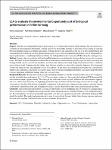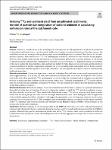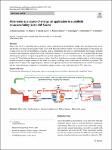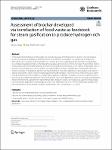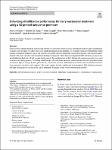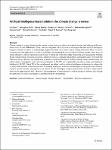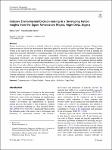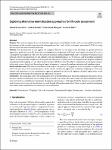Search
Author
- Osman, Ahmed I. (5)
- Chen, Zhonghao (2)
- Ricohermoso III, Emmanuel (2)
- Wang, Yongbin (2)
- next >
Subject
- LCA (6)
- ICP-MS (3)
- Artificial intelligence (2)
- CDW (2)
- next >
Date issued
Has File(s)
- true (220)
Search Results
Mortality and suboptimal biological performance are a widespread problem in finfish farming. The associated losses constitute an environmental opportunity cost that needs to be thoroughly assessed to prioritize actions aiming at reducing the environmental impacts of finfish aquaculture. We here propose and demonstrate the use of a new parameterized and consequential LCA model of sea-trout production designed to assess the environmental opportunity costs of suboptimal biological performances, considering distinct mortalities and biological feed conversion ratios (FCRs) along the rearing process. |
Soil loss is considered one of the most important consequences of land degradation as it affects the production of agricultural and forested areas, and the natural equilibrium of aquatic ecosystems downstream. For these reasons, the availability of tools and techniques able to identify areas at risk of land degradation is essential. Over the last 3–4 decades, theoretical models, based on the use of 137Cs, an anthropogenic radiotracer, proved to be very effective for this purpose. However, these models require specific information on soil and sediment particle size to provide estimates of soil erosion or deposition and this information is summarised by a particle size correction factor ‘P’. |
Mine water can be a renewable and economical source of geothermal and hydraulic energy. Nine discharges from closed and flooded coal mines in the Laciana Valley (León, NW Spain) have been studied. Various technologies for the energy use of mine water, as well as the influence of factors such as temperature, the need for water treatment, investment, potential customers and expansion capacity, have been evaluated by means of a decision-making tool. It is concluded that the most advantageous option is an open-loop geothermal system using the waters of a mountain mine, the temperature of which exceeds 14 °C and whose distance to customers is less than 2 km. A technical–economic viability study for a district heating network designed to supply heating and hot water to six public building... |
Australian tidal wetlands differ in important respects to better studied northern hemisphere systems, an artefact stable to falling sea levels over millennia. A network of Surface Elevation Table-Marker Horizon (SET-MH) monitoring stations has been established across the continent to assess accretionary and elevation responses to sea-level rise. This network currently consists of 289 SET-MH installations across all mainland Australian coastal states and territories. SET-MH installations are mostly in mangrove forests but also cover a range of tidal marsh and supratidal forest ecosystems. Mangroves were found to have higher rates of accretion and elevation gain than all the other categories of tidal wetland, a result attributable to their lower position within the tidal frame (promot... |
In this study, the torrefaction of food waste was carried out using a thermogravimetric analyzer (TGA) to produce biochar and assess its suitability as feedstock for steam gasification. Torrefaction was conducted at temperature from 230 to 290 °C and the heating rate from 10 °C/min to 30 °C/min. Subsequently, the detailed characterization was conducted using proximate, elemental, lignocellulosic, nutrient analysis, and TGA analysis. The proximate and elemental analysis showed that biochar had the highest fixed and elemental carbon at the highest temperature (290 °C) and lowest heating rate (10 °C/min). Similarly, TGA indicated that increase in temperature increased the mass loss, however, increase in heating rate did not yield much change in mass loss. Additionally, lignocellulosic ... |
Carbon Integration methods help identify the appropriate allocation of captured carbon dioxide (CO2) streams into CO2-using sinks, and are especially useful when a number of CO2 sink options are present simultaneously. The method helps identify CO2 allocation scenarios when subjected to an emission target on the CO2 overall network. Many carbon dioxide sink options are costly, and more often than not, require a high purity carbon dioxide source to satisfy the sink demand. Hence, it is imperative to effectively incorporate treatment units in such networks, to obtain high-purity CO2 streams. In fact, it has been previously reported in many studies that the most expensive step in Carbon Capture, Utilization and Sequestration (CCUS) is the treatment system. |
Dairy factories annually generate an increasing amount of wastewater, which can cause eutrophication due to high concentrations of amino acids and lipids. To address this issue, membrane technology has emerged as a promising solution, but membrane fouling remains a significant challenge, since it can cause decreased flux, decrease membrane rejection performance, and increased energy demand. This study aimed to reduce membrane fouling by integrated a three-dimensional printed (3DP) turbulence promoter into an ultrafiltration dead-end cell and varying stirring speeds. Two mathematical models, Hermia and resistance-in-series, were used to analyze the fouling process. According to both models, the cake layer formation model indicated the most prevalent fouling mechanism. Specific energy... |
Climate change is a major threat already causing system damage to urban and natural systems, and inducing global economic losses of over $500 billion. These issues may be partly solved by artificial intelligence because artificial intelligence integrates internet resources to make prompt suggestions based on accurate climate change predictions. Here we review recent research and applications of artificial intelligence in mitigating the adverse effects of climate change, with a focus on energy efficiency, carbon sequestration and storage, weather and renewable energy forecasting, grid management, building design, transportation, precision agriculture, industrial processes, reducing deforestation, and resilient cities. |
Greater involvement of women is globally believed to enhance environmental management outcomes. Despite being disproportionately affected by environmental degradation primarily caused by oil spills in the Niger Delta region of Nigeria, women in the region are often excluded in environmental decision-making processes. Women involved in farming and fishing face increased vulnerability to contaminated land, food insecurity and conflicts driven by environmental degradation. Using a mixed approach, women, lawmakers, policymakers, regulators, civil society organizations, environmental management practitioners, and government agents responsible for environmental remediation were engaged through interviews, focus group discussions and questionnaires to examine women’s inclusion in environme... |
This work investigates the use of alternative approaches to normalization in life cycle assessment (LCA) and shows the relevance of the normalization step in the interpretation of the results of life cycle impact assessment (LCIA) by testing the use of five alternative normalization sets. |

